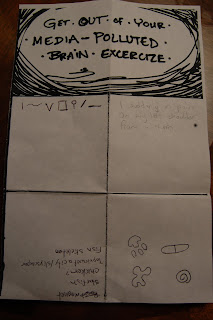
Here there is a picture of my four-square prompt; it represents the cognitive functions of every person that wrote on this sheet of paper. Here's how it goes. Everything becomes sedated with one another. That's all I know. And it's by far the most intrenching post I have been able to get access towards. The first square undoubtedly unfolds to us some kind of incongruence between states of mind of this person. He/she thinks of a triangle when he/she hears the word "tick". As well, the issue of filtering becomes apparent because he/she doesn't seem to understand what the image constitutes of. Secondly, as we proceed to the other, more elegant picture of this drawer, it seems that this drawer doesn't seem to acknowledge shape when it comes to drawing well. This means that he/she probably hates to use detail when regarding shape; simply he/she doesn't regard the use of these shapes as important. Importance comes at a cost. Regarding whoever did the second bunch of words, it seems perfection is kept wisely at bay. This person tries to establish a sense a belonging with the viewer - seeks to connect his/her experience with the viewer. He or she tries to establish a sense of security. Under scrutiny, this person relevantly chooses to not mention horrific details of the gore; rather, he or she decides to establish a sense of belonging and a sense of familiarity by doting the word "Meijer" on the image.
For the third image, the shapes are relevant to the issue, yet vague in that they don't really capture the essence of familiarity. For example, the shapes are very detailedly drawn, which is a good sign that whoever made this intended to get a good representation of the ideological demonstration circulating within his or her mind. Reed made a mention to "Medicine". This represents his or her view of such thing; therefore, it is hard to tell whether he or she intended for the viewer to feel anything regarding this issue. It also raises the question: how does his or her mind evaluate subjects to get a clear composure on the meaning of intelligence?
The meaning of intelligence raises a powerful awareness of things like racism, discrimination within the mind. This discrimination within itself is a large topic to seek. To communicate with somebody about this issue is a highly stifled topic in today's society. Today's society relies on racism or other things like the discrimination of minds and the highly intelligent. Neuroscientists tailor their research statements to only the privileged. Therefore, it is the highly privileged in society that demonstrate a crave for such matters. This bases it's publication on societal themes regarding brilliance and the sought-after intellectual. The elusive intellectual. The intellectual whose mind is shunned from the rest of the world because of hatred towards this intellectual stereotype. It raises awareness about how this society seeks to evolve - when it does so, and how everyone around this political figure seeks to mesmerize things like ambiguity.
Shortly put, this stereotype and succinct fear of intellectuals seeks to diminish intellectuals' identities itself. However morbid, it is consequential.
The fourth and last cuticle contains words written by me. Sometimes I don't understand or comprehend how these things come into being. These images that were drawn were a little bit out of the ordinary. On there there is not reference to any of the above. None of it. Rather, it is an analytical voice and compensation for the knowledgeably devoid. It is decrepit, imaginative, forceful, and anxiety-ridden. It's just like that. Spontaneous, perhaps.








